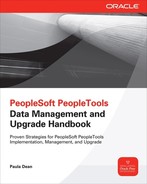
Appendix
A
Manually Applying Patches and Bundles
 n Chapters 6 and 7 you learned how to use the Environment Management Framework (EMF) and Change Assistant to apply patches, bundles, and maintenance packs. If you are not able to use these tools within your organization, you will have to apply maintenance manually. In this appendix you will learn tips to guide you through the change package application process so you can feel comfortable applying maintenance without Change Assistant and the EMF. For smaller bundles and updates, applying maintenance manually can be faster than using Change Assistant.
n Chapters 6 and 7 you learned how to use the Environment Management Framework (EMF) and Change Assistant to apply patches, bundles, and maintenance packs. If you are not able to use these tools within your organization, you will have to apply maintenance manually. In this appendix you will learn tips to guide you through the change package application process so you can feel comfortable applying maintenance without Change Assistant and the EMF. For smaller bundles and updates, applying maintenance manually can be faster than using Change Assistant.Download the Update
As you learned in Chapter 7, PeopleSoft delivers periodic maintenance updates as Zip files. Follow the manual discovery steps in Chapter 7 to identify and download updates required for your system. The download location is not important; just remember where you place them. You will run all commands yourself and will have the opportunity to update file locations accordingly.
Extract the Update Archive
After downloading updates, unzip each file into its own directory. Since I am usually performing updates from my local workstation and have no desire to maintain those updates in my file system, I usually unzip maintenance files into subdirectories of my
c: emp folder. After applying maintenance, you can copy these files into a permanent storage location.Apply the Update
Oracle delivers everything you need, including a document detailing the steps required to apply the selected maintenance; you just have to know where to find the document.
Identify Maintenance Documentation
All PeopleSoft maintenance archives have the prefix upd followed by the update ID. After expanding the archive, open the
updxxxxxx folder and then look for the updxxxxxx_install folder. Inside that folder, you will find an HTML document named updxxxxxx_install.htm. This HTML document contains step-by-step instructions for applying the downloaded maintenance to your PeopleSoft system. For example, in Chapter 7, we applied upd860101. Inside the upd860101upd860101_install folder is an HTML document named upd860101_install.htm containing step-by-step instructions.Follow the Instructions
The HTML documentation contains every step required to apply maintenance as well as many generic steps. Due to the generic nature of the documentation, some steps may not apply to your environment. Most of the documented steps describe the action Change Assistant would perform if the step was required. For example, upd860101 from Chapter 7 contains the instruction, “Step: Run Create Triggers Script,” regardless of whether that applies to your maintenance on your system.
Perform each task in the order specified within the HTML documentation. I often print a copy so I can check off each step as I finish.
| CAUTION
Perform tasks in the order identified in the documentation. Bundles and other maintenance may include data structure changes and conversion routines. Running those conversion routines before applying data structure changes may result in database corruption. |
Unfortunately, the documentation is written from Change Assistant’s perspective, telling you what Change Assistant will accomplish when performing each task. When reading the documentation, just convert the phrase “Change Assistant will” to “I will.”
Pay special attention to instructions in blue text. The main text of the change package’s instructions may contain several irrelevant steps. Anything in blue was intentionally inserted and requires action.
Change Projects
Downloaded maintenance archives often include Application Designer change projects. Prior to applying a change project, run a file compare as described in Chapter 11. This will identify any modifications your site has made to delivered definitions. Note these changes so you can reapply them after importing the change project.
Files
Most of the steps involve files: deploying files and running files. The instructions are rather generic regarding deployment locations. It is not possible for Oracle to document exact deployment locations given PeopleSoft’s flexible deployment options. Change Assistant knows where to deploy files based on EMF and Change Assistant configurations. Since you are not using these tools, you will need to identify your application server, web server, file server, and process scheduler file systems including
PS_HOME, PS_CFG_HOME, and PS_APP_HOME.Before running Data Mover scripts, review their contents and look for file references. Often Data Mover scripts include
INPUT and LOG directives as relative file paths and assume that files exist in the Data Mover input, output, and log directories (see Chapter 3 for more information). If your maintenance input files exist in a different location, be sure to update the Data Mover script accordingly.Binary File Considerations
Some PeopleSoft maintenance items include Java and other binary files. Deploying these files may require you to restart your web server, application server, or batch server. Be sure to make note of this and schedule maintenance accordingly.
Conclusion
Because each change package is a little different, it is not possible to document fully the steps required to apply every change package manually. In this appendix you learned tips to guide you through the change package application process so you can feel comfortable applying maintenance without the assistance of Change Assistant and the EMF.
..................Content has been hidden....................
You can't read the all page of ebook, please click here login for view all page.
